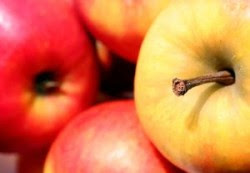 You may remember than my oldest daughter has taken quite an interest in making candy. She needed to get some pecans to make pralines, so I heroically volunteered to drive her to the grocery store for them.
You may remember than my oldest daughter has taken quite an interest in making candy. She needed to get some pecans to make pralines, so I heroically volunteered to drive her to the grocery store for them.I don't know how much of a hero I really was. I was going to get eggs and some vanilla that night, anyway, but I like to think I'm heroic where my daughter's are concerned. It's this little illusion I create for myself, as their father. They know better, but are polite enough not to say anything.
Against my recommendations, she got the caramel made up and cooling before we left. We only needed three or four items so it wasn't going to take very long.
Yeah, right.
I tend to linger in the grocery aisles a bit, especially if something catches my eye. What caught my eye first, was a friend and neighbor who also happens to be a good home cook.
For some reason that I can't remember, he needed to replace his large cooking pot. He wasn't impressed with the prices there, and I wasn't impressed with the quality. We talked cooking gear as hard as any weekend woodworking warrior would at Home Depot. “Yeah, it looks bonded, but from the heft I'd guess it's got a hollow core, not an aluminum one,” and so on.
After several minutes of this my daughter ... remember my daughter? This story is about her, after all.
Anyway, my daughter was trying to speed things up and had found the vanilla. “Will this do? It's the cheapest.”
“It is imitation?” I asked.
“Yeah, but it's less expensive than this other one.”
I shook my head. “No, honey. Never buy imitation vanilla. It's crap. Get the natural stuff.” I promptly went back to the discussion of stock pot construction techniques.
My daughter chimed in again. “Dad? Candy? Remember?”
“Oh, yeah. She's started making candies these days. It's really quite something,” I told my friend, not quite getting the hint.
“Dad! We have to get back, remember?” my daughter said, in earnest.
“Okay. I guess we better go. We've got to get back before her caramel cools too much.” I finally said, and my friend and I parted ways.
Stepping a little farther down the aisle we found the pecans. “$10.00 a pound? Holy cow. I didn't realize they'd be so expensive. I'm not sure we don't need two of these.” I exclaimed in horror.
Sidestepping the issue, my daughter asked, “How many of these packages do we really need?”
Upon further inspection I thought we'd be okay with the one pound package, but just barely. To be honest, I was being hopeful. I knew that two packages would be too many and, frankly, I didn't want to pay $20.00 for pecans just to make candy. I'm kinda cheap that way. It turned out I was right. We had just barely 4 cups of chopped nuts.
“Okay, let's get the eggs and then we can go.” my daughter pressed.
We found the eggs, but along the way we also went down the picnic items aisle. This aisle has all the ketchup and mustard and hot sauce and, well, I did need some more.
I grabbed a bottle of Louisiana style hot sauce and started comparing it with the Tabasco brands when my daughter broke my reverie, “Dad? Candy?”
“Oh, okay.” I said. “I just need some of this,” and I put the Louisiana style hot sauce in our small basket.
The trouble is, the olives and pickles were farther down that same aisle. As I stopped once again, distracted by some garlic-stuffed green olives, my daughter spoke up again.
“No, Dad. No! No more looking! We have to go. No looking!” She hunched her shoulders and waved her hands furiously at me for emphasis.
Trying not laugh, I closed my eyes and left the aisle with her. She had a good point, but she just looked so cute waving her hands around that I just had to smile.
The rest of the trip was uneventful. We got through the checkout quickly and painlessly. When we got home, though, the caramel had indeed cooled a bit more than I thought was good. My daughter was undaunted. I showed her how to chop the pecans with a heavy chef's knife and she stirred them in.
We realized, too late, that we didn't have enough waxed paper to spread out on the table so, we sprayed some baking sheets and she started to drop the praline mixture onto them to cool and harden. The caramel was more than soft. Runny, would be more accurate. I didn't think it had been cooked long enough, so I made her bring it to a boil again and then let it cool enough to deal with. That did the trick, mostly, and she was able to get them laid out on the baking sheets in record time. Once again, I listened to the voice in my head saying, Shut up, John, and just let her have at it.
I shouldn't have worried. They were the softest pralines I've ever eaten, to be sure, but they were quite tasty. So tasty, in fact, that it was hard to stop eating them. Once again, my daughter had created something wonderful. Not quite a confectionary triumph, but very close. Close enough that we devoured them all in two days.
Next, she's planning on making a caramel pudding-cake.
Photo by Michael W.











